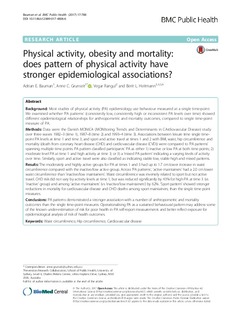| dc.contributor.author | Bauman, Adrian E. | |
| dc.contributor.author | Grunseit, Anne C. | |
| dc.contributor.author | Rangul, Vegar | |
| dc.contributor.author | Heitmann, Berit Lilienthal | |
| dc.date.accessioned | 2018-08-16T12:31:08Z | |
| dc.date.available | 2018-08-16T12:31:08Z | |
| dc.date.created | 2018-01-05T16:49:08Z | |
| dc.date.issued | 2017 | |
| dc.identifier.issn | 1471-2458 | |
| dc.identifier.uri | http://hdl.handle.net/11250/2558304 | |
| dc.description.abstract | Background
Most studies of physical activity (PA) epidemiology use behaviour measured at a single time-point. We examined whether ‘PA patterns’ (consistently low, consistently high or inconsistent PA levels over time) showed different epidemiological relationships for anthropometric and mortality outcomes, compared to single time-point measure of PA.
Methods
Data were the Danish MONICA (MONItoring Trends and Determinants in CArdiovascular Disease) study over three waves 1982–3 (time 1), 1987–8 (time 2) and 1993–4 (time 3). Associations between leisure time single time-point PA levels at time 1 and time 3, and sport and active travel at times 1 and 2 with BMI, waist, hip circumference and mortality (death from coronary heart disease (CHD) and cardiovascular disease (CVD)) were compared to ‘PA patterns’ spanning multiple time points. PA pattern classified participants’ PA as either 1) inactive or low PA at both time points; 2) moderate level PA at time 1 and high activity at time 3; or 3) a ‘mixed PA pattern’ indicating a varying levels of activity over time. Similarly, sport and active travel were also classified as indicating stable low, stable high and mixed patterns.
Results
The moderately and highly active groups for PA at times 1 and 3 had up to 1.7 cm lower increase in waist circumference compared with the inactive/low active group. Across ‘PA patterns’, ‘active maintainers’ had a 2.0 cm lower waist circumference than ‘inactive/low maintainers’. Waist circumference was inversely related to sport but not active travel. CHD risk did not vary by activity levels at time 1, but was reduced significantly by 43% for high PA at time 3 (vs ‘inactive’ group) and among ‘active maintainers’ (vs ‘inactive/low maintainers’) by 62%. ‘Sport pattern’ showed stronger reductions in mortality for cardiovascular disease and CHD deaths among sport maintainers, than the single time point measures.
Conclusions
PA patterns demonstrated a stronger association with a number of anthropometric and mortality outcomes than the single time-point measures. Operationalising PA as a sustained behavioural pattern may address some of the known under-estimation of risk for poor health in PA self-report measurements and better reflect exposure for epidemiological analysis of risk of health outcomes. | nb_NO |
| dc.language.iso | eng | nb_NO |
| dc.publisher | BioMed Central | nb_NO |
| dc.rights | Navngivelse 4.0 Internasjonal | * |
| dc.rights.uri | http://creativecommons.org/licenses/by/4.0/deed.no | * |
| dc.title | Physical activity, obesity and mortality: Does pattern of physical activity have stronger epidemiological associations? | nb_NO |
| dc.type | Journal article | nb_NO |
| dc.type | Peer reviewed | nb_NO |
| dc.description.version | publishedVersion | nb_NO |
| dc.source.volume | 17 | nb_NO |
| dc.source.journal | BMC Public Health | nb_NO |
| dc.source.issue | 1 | nb_NO |
| dc.identifier.doi | 10.1186/s12889-017-4806-6 | |
| dc.identifier.cristin | 1536911 | |
| dc.description.localcode | © The Author(s). 2017 Open Access This article is distributed under the terms of the Creative Commons Attribution 4.0 International License (http://creativecommons.org/licenses/by/4.0/) | nb_NO |
| cristin.unitcode | 194,65,20,15 | |
| cristin.unitcode | 194,65,20,0 | |
| cristin.unitname | Helseundersøkelsen i Nord-Trøndelag | |
| cristin.unitname | Institutt for samfunnsmedisin og sykepleie | |
| cristin.ispublished | true | |
| cristin.fulltext | original | |
| cristin.qualitycode | 1 | |

